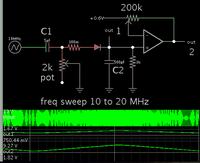- Joined
- Apr 1, 2011
- Messages
- 15,177
- Helped
- 2,899
- Reputation
- 5,810
- Reaction score
- 2,982
- Trophy points
- 1,393
- Location
- Minneapolis, Minnesota, USA
- Activity points
- 113,690
Can you help me design a more sharp (the sharpest the better) tuneable RC HPF fot HF?
Cheers
Another thing to try, is to take advantage of the steep curve of a high Q resonant filter. You can tap to the right or the left of the center frequency.
You would need to adjust the LC frequency so it is a few MHz distant from whatever is your desired frequency.
Another concept. You can make the curve steeper by amplifying the output. For instance, via a transistor amplifier.
Another concept. Put a diode inline, and you subtract 0.6V. Then by amplifying this, you obtain a steeper curve.
